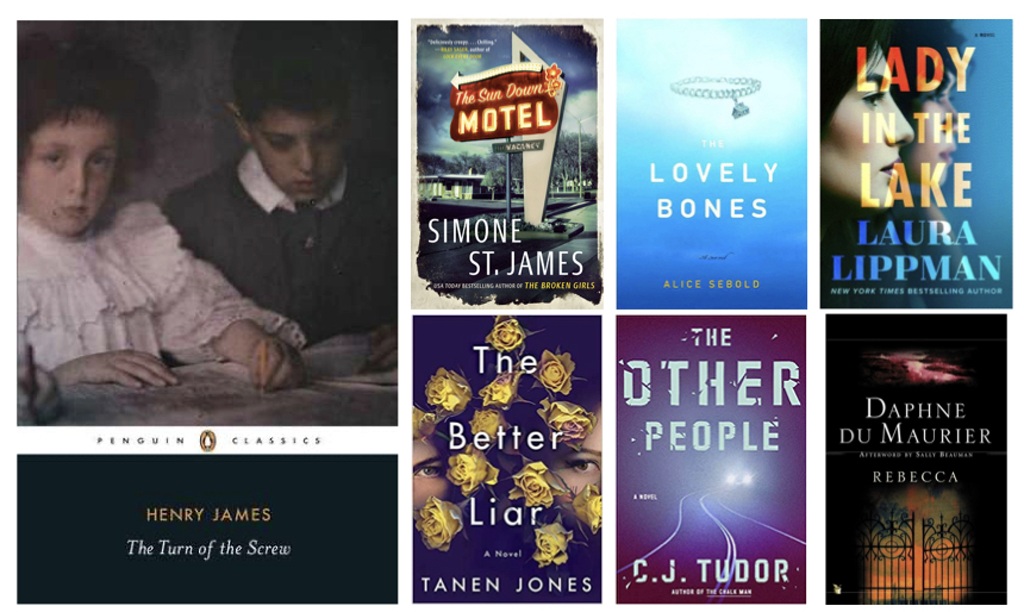It’s time for another adventure in Kate’s 6 Degrees of Separation Meme from her blog, Books Are My Favourite and Best. We are given a book to start with, and from there we free associate six books.
This month we start with The Turn of the Screw by Henry James, an appropriate choice for the Halloween season because it features ghosts.
Or does it?
The most salient feature of James’s novella is its ambiguity. Are the ghosts the governess sees real, or are they the product of some psychological projection such as fear, prurience, desire, or repressed sexuality? About 10 years after the book’s publication James wrote that he purposely made the story so ambiguous because a shadowy picture of evil allows readers to fill in the picture with the details that frighten them the most.
Because the ghost story is pregnant with possibilities, it has a long literary history.
The American literary ghosts I love most aren’t psychological shadows—they are solid enough to slam doors. But they’re not horror movie monsters either. They’re conflicted beings with messages more complicated than the expected “avenge me” spiel; they want us to think about what it means to be a human in the world.
—Amy Shearn
Here are six ghost stories that illustrate the variety of ways authors have chosen to present their ghosts. The final one is English rather than American, but it’s such a giant of the ghost-story canon that I couldn’t leave it out.
1. The Sun Down Motel by Simone St. James clearly follows the ghost story’s gothic origins in its use of a building where ghosts prowl. When Carly Kirk sets out to explore the disappearance of her aunt while working at the Sun Down Motel 35 years earlier, she comes up against a classic struggle of good vs. evil when two ghosts face off in a confrontation of apocalyptic proportions.
2. Sometimes a ghost gets to narrate its own story, as does Susie Salmon in The Lovely Bones by Alice Sebold. After being murdered at age 14, she watches from her own personal version of heaven as the police investigate the crime and as her family and friends adjust to life without her. (This book is nowhere near as ghastly as the short description might make it sound. It’s done with great sensitivity and insight.)
3. A ghost as narrator also appears, although only sporadically, in Laura Lippman’s Lady in the Lake. Based on the unsolved murder of a Black woman in the 1960s in Baltimore, Lippman creates a picture of the seething social and racial tensions in the city at that time. The murdered woman is not the central figure in the story, but her ghost appears periodically to help explain the zeitgeist of the era.
4. A ghostly narrator introduces The Better Liar by Tanen Jones with this dramatic statement: “Like most of the dead, I want to be remembered.” Leslie hasn’t seen her younger sister, Robin, since Robin ran away from home 10 years earlier, at age 16. But the women’s father has stipulated in his will that the two women must appear together, in person, at his attorney’s office to receive their inheritance. Leslie, who really needs the money, sets out in search of Robin, whom she finds in a rooming house, dead from a drug overdose. But Leslie really needs that inheritance money . . .
5. C.J. Tudor uses three types of ghosts in The Other People. Driving home through rush-hour traffic one night, Gabe sees his daughter, Izzy, looking out the back window of the car in front of him. She mouths the word “Daddy,” but Gabe loses the car in the traffic. He never sees Izzy again. Gabe quits his job, buys a camper, and spends the next three years driving up and down the same stretch of highway where he last saw his daughter. Haunted by the vision of his missing daughter, Gabe himself haunts the highway and the rest areas along his route. Meanwhile, Fran and her young daughter are on the run along the same highway. Fran’s daughter, Alice, periodically falls into sessions of deep sleep during which she sees a vision of a young girl in a while dress. This is one truly haunted novel, perfect for Halloween season.
6. Sometimes what haunts a story is not some other-worldly presence, but a palpable absence. Such is the case in Rebecca by Daphne du Maurier, in which a second wife feels compelled to live up to the reputation of her predecessor.
After many different types of ghosts, we’re back again to a novel chillingly haunted by the ghost of possibility. Perhaps that’s why The Turn of the Screw and Rebecca are two of the best known ghost stories in Western literature.
© 2020 by Mary Daniels Brown


Scary short stories scare me infinitely more than scary novels for exactly the reason that James left his book ambiguous–I fill in the gaps and scare myself more than an author ever could.
The Other People sounds haunting. I’ll have to look for it.
Rebecca is an old favorite. It’s amazing how Rebecca is practically the main character even though she doesn’t put in an appearance in the story’s timeline. The Lovely Bones was also surprisingly good and poignantly written.
Great list!
Thanks, Jen!
Pingback: Re-Examining My Stance on Horror – Notes in the Margin